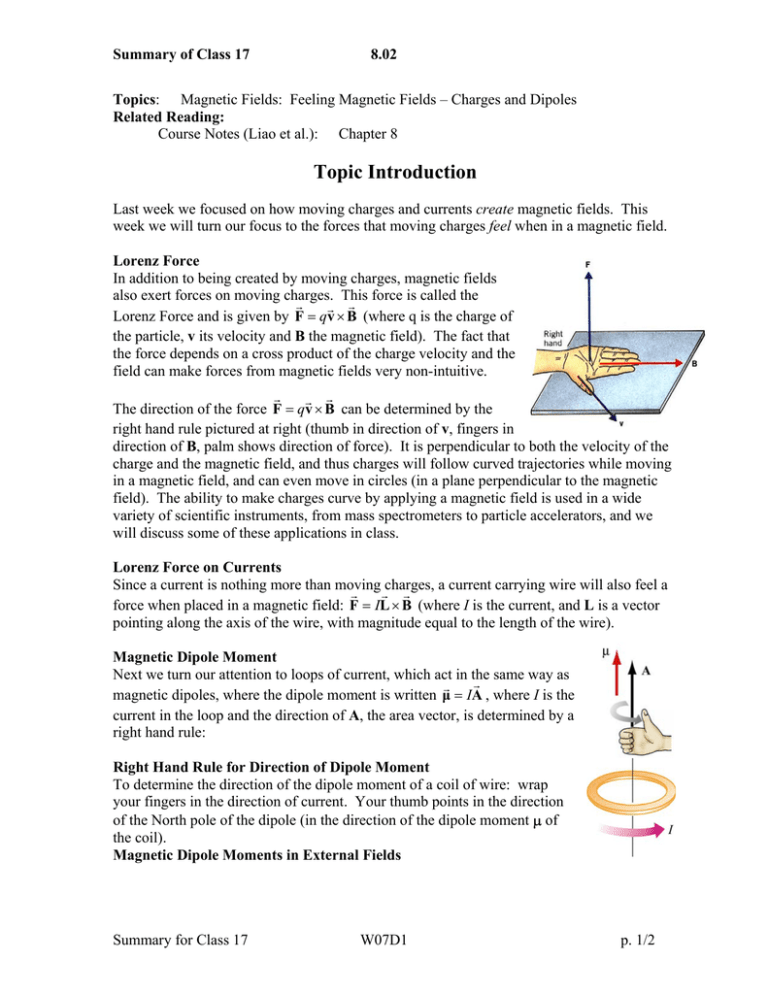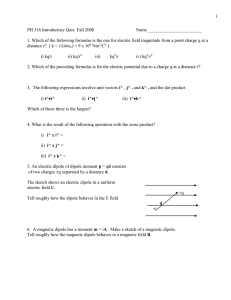Topic Introduction
advertisement

Summary of Class 17 8.02 Topics: Magnetic Fields: Feeling Magnetic Fields – Charges and Dipoles Related Reading: Course Notes (Liao et al.): Chapter 8 Topic Introduction Last week we focused on how moving charges and currents create magnetic fields. This week we will turn our focus to the forces that moving charges feel when in a magnetic field. Lorenz Force In addition to being created by moving charges, magnetic fields also exert forces on moving charges. This force is called the G G G Lorenz Force and is given by F = qv × B (where q is the charge of the particle, v its velocity and B the magnetic field). The fact that the force depends on a cross product of the charge velocity and the field can make forces from magnetic fields very non-intuitive. G G G The direction of the force F = qv × B can be determined by the right hand rule pictured at right (thumb in direction of v, fingers in direction of B, palm shows direction of force). It is perpendicular to both the velocity of the charge and the magnetic field, and thus charges will follow curved trajectories while moving in a magnetic field, and can even move in circles (in a plane perpendicular to the magnetic field). The ability to make charges curve by applying a magnetic field is used in a wide variety of scientific instruments, from mass spectrometers to particle accelerators, and we will discuss some of these applications in class. Lorenz Force on Currents Since a current is nothing more than moving charges, a current carrying wire will also feel a G G G force when placed in a magnetic field: F = IL × B (where I is the current, and L is a vector pointing along the axis of the wire, with magnitude equal to the length of the wire). Magnetic Dipole Moment Next we turn our attention to loops of current, which act in the same way as G G magnetic dipoles, where the dipole moment is written µ = IA , where I is the current in the loop and the direction of A, the area vector, is determined by a right hand rule: Right Hand Rule for Direction of Dipole Moment To determine the direction of the dipole moment of a coil of wire: wrap your fingers in the direction of current. Your thumb points in the direction of the North pole of the dipole (in the direction of the dipole moment µ of the coil). Magnetic Dipole Moments in External Fields Summary for Class 17 W07D1 p. 1/2 Summary of Class 17 8.02 Magnetic moments behave in magnetic fields the same way that electric dipole moments behave in electric fields. If not aligned with the field, the dipole experiences a torque trying G G G to align it: τ = µ × B . If (and only if) the field is non-uniform it will feel a force. Forces on Magnetic Dipole Moments Although it is possible to calculate forces on dipole G G G G moments using an equation FDipole = µ ⋅∇ B it’s ( ( ) ) actually much more instructive to think about what forces will result by thinking of the dipole as one bar magnet, and imagining what arrangement of bar magnets would be required to create the non-uniform magnetic field in which it is sitting. Once this has been done, determining the force is straight forward (opposite poles of magnets attract). N S N As an example of this, consider a current loop sitting in a diverging magnetic field (pictured above). In what direction is the force on the loop? In order to answer this question one could use the right hand rule and find that the force on every current element is outward and downward, so the net force is down. An often easier way is to realize that the current loop looks like a bar magnet with its North pole facing up and that the way to create a field as pictured is to put another bar magnet with North pole up below it (as pictured at left). Once redrawn in this fashion it is clear the dipole will be attracted downwards, towards the source of the magnetic field. A third way to think about the forces on dipoles in fields is by looking G G at their energy in a field: U = −µ ⋅ B . That is, dipoles can reduce their energy by rotating to align with an external field (hence the torque). Once aligned they will move to high B regions in order to further reduce their energy (make it more negative). S Important Equations Force on Moving Charges in Magnetic Field: Force on Current-Carrying Wire of Length L: Magnetic Moment of Current Carrying Wire: Torque on Magnetic Moment: Energy of Moment in External Field: Summary for Class 17 W07D1 G G G F = qv × B G G G F = IL × B G G µ = IA (direction from RHR above) G G G τ = µ×B G G U = −µ ⋅ B p. 2/2





